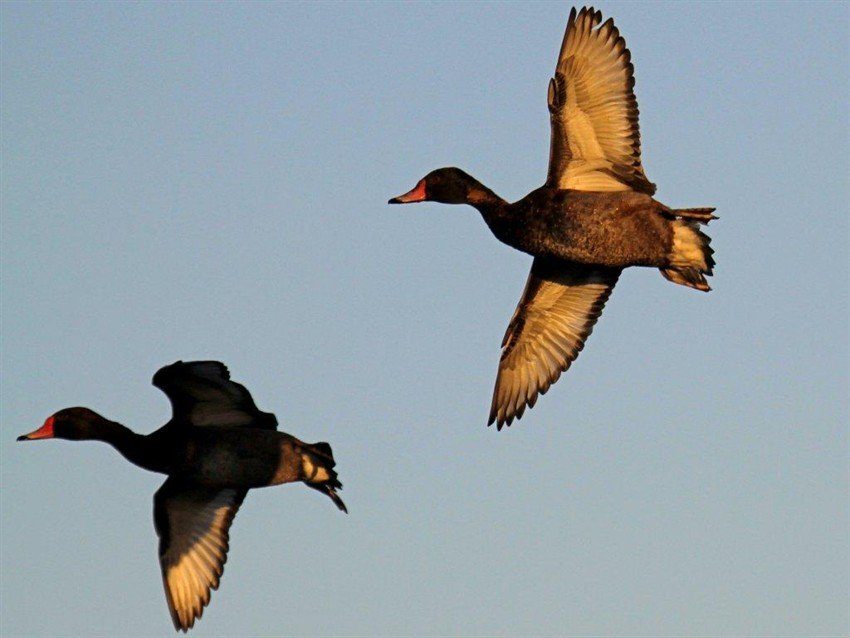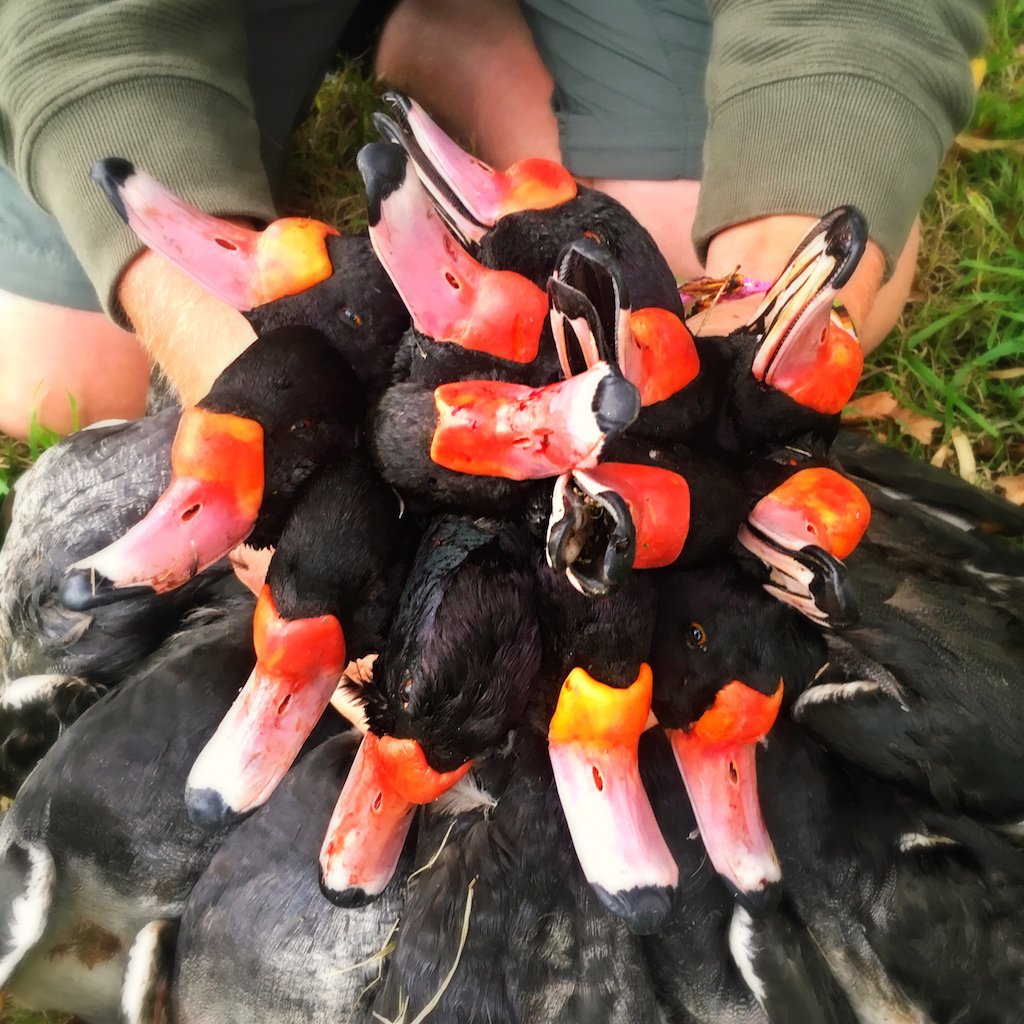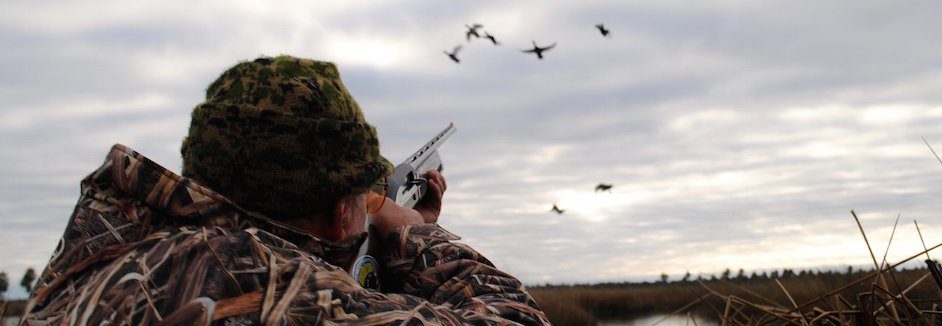Rosy-billed Pochard
Rosy-billed Pochard (Netta peposaca), also known as the Rosybill or Rosybill Pochard, is a native waterfowl species found in South America. Males are entirely dark with the exception of their red bills and irises and their pale-yellow legs and feet. They display a large knob where the bill meets the face, being one of the most prominent feature on their body. The bill is also tipped with black. Rosy-billed Pochard plumage from the head down to the breast is jet-black and can be seen as iridescent purple in the right lighting. The underbelly is extremely vermiculated with white and gray, almost to the point where it only looks gray. The tail is black with a large white spot on the underside. When in flight, the wings have large bands of white running from the primaries to the speculum that are either edged with black or iridescent green. Females lack the knob on the bill and are mostly chestnut in color. The underside of the tail is white as seen in the male.
Rosy-billed Pochards are found in Argentina, Chile, Paraguay, Uruguay, and Brazil. While the rosybill population in southern Argentina migrates to Brazil and Bolivia for the winter, Rosy-billed Pochards are mostly a resident species. Favored habitat for Rosy-billed Pochard is wetlands with abundant, tall grasses. Other frequented habitat includes freshwater swamps, marshes, and small lakes. As a whole, the Rosy-billed Pochard is highly gregarious and often seen in flocks in the thousands. Individuals do not form strong, lifelong bonds and are not monogamous either. Males and females only form seasonal bonds, which last the duration of the breeding season from October to November.

Available Hunts
-
Argentina Duck Hunt – Parana River Delta
An Argentina duck hunt destined to become absolute legend, the Parana River Argentina duck hunting an immersive adventure in one of the wildest places ever.
...read more- Wildest, most remote duck hunt in Argentina, pure adventure
- Luxury liveaboard accommodations, < 15 minutes from duck blind
- Amazing gourmet meals, excellent wine selection (an Argentina wine tasting offered each week)
- Located about 4-5 hours travel from downtown BA, last 1.5 hours by boat
- Rosy-billed pochards, white-cheeked pintails and teal predominate the bag
- Choose high-volume ducks twice daily, or afternoon golden dorado fishing
Rate: $975 -
Argentina Duck Hunt La Paz
La Paz Argentina Duck hunting combo is true, high-quality trigger-pulling vacation for ducks, doves, perdiz, pigeons, fishing, more.
...read moreArgentina duck hunting La Paz combo package features duck hunts combined with high-volume dove hunting, world-class perdiz hunting, decoying pigeon, golden dorado fishing. Great value, a real client favorite.
- Customizable itinerary for ducks, doves, pigeons, perdiz, fishing
- Nearby non-hunting activities, fun for spouses and entire family
- Excellent chef-prepared meals, unrivaled hospitality
- Private suite lodging, casual family atmosphere
- Personal concierge services entire trip
- As featured on MOJO TV
Rate: $3,950 inclusive 3-day package -
Argentina Duck Hunting Las Flores
High-volume Argentina duck hunting is a "real duck hunter's duck hunt" that consistently produces over-the-top action. You've tried the rest, now come try the very best!
...read moreArgentina duck hunting Las Flores is our poster-boy Argentina duck hunt. For over a decade, this operator consistently delivers generous duck limits without fail. Convenient hunt that all duck hunters will enjoy.
- Fun, fast-paced duck hunts, generous limits every single day without excuses
- Tons decoying rosy-bills, all Argentina species available
- Located 5.5 hours from EZE, < 30 minutes to blinds
- Great lodging, superior meals, best-stocked bar in Argentina
- As featured MOJO TV; Wildfowl, Predator Nation, Peterson’s and Trigger, Field & Stream, more
Rate: $1,150 -
Argentina Duck Hunting Los Ceibos Combo
Excellent Argentina duck hunting combo program, fully customizable to include doves and perdiz and is conveniently located within few hours easy drive time.
...read moreArgentina Duck Hunting Los Ceibos Combo is perfect for clients with limited mobility or that do not want to pack lots of gear. Daily morning duck hunts, hunters choice of perdiz or doves during afternoons.
- Fully customizable shooting program – choose any daily combination of ducks, doves, perdiz
- Located within easy hours very easy drive on International Highway 14 from EZE
- Several authentic estancias, hunting never more than 20 minutes away
- Never mixed with other groups, regardless of party size!
- Excellent bilingual host entire trip
- Nearby non-hunting activities
Rate: $850 -
Argentina Duck Hunting Rio Salado
High-volume Argentina duck hunting a remote wetland that's well worth the effort.
...read moreArgentina duck hunting Rio Salado for die-hard duck hunters that will go the distance for high-volume shooting, high species diversity, and unspoiled habitat. Welcome to real Argentina.
- NO LONGER BOOKING THIS HUNT!
- Remote 74,000-acre wetland
- 1 hunter per blind unless requested
- Pure duck hunting
- Bilingual hosting for the entire trip
- Featured MOJO TV, Outdoor Life, Wildfowl, Sports Afield
Rate: N/A
While technically designated a diver, the Rosy-billed Pochard typically forages in a dabbling manner. All 3 species in the Netta genus behave similarly as “false divers.” Diet consists mostly of a variety of seeds but supplement with grasses, roots, sedges, and aquatic plants. Rosy-billed Pochards are classified as omnivores as they consume animal matter while foraging for plants. It has been recorded that they are highly adaptable with food sources that are available to consume, which gives them an advantage during years of poor plant growth.
ROSY-BILLED POCHARDS. The true king of South American ducks. Responding to calls, hard-charging divers that sweep over the decoys with a roar, they’re as absolutely delicious as they are fun. Many beautiful species here, but we old salts want the rosybills above all else. There are plenty other species to be had while duck hunting Argentina, sure, all of the usual suspects and plenty of them, but every single client that has been here for the past decade says exactly the same thing: “that number of decoying rosy-bills was amazing!” Yes, my favorite duck is the next one over the decoys, but my heart swells when hoisting a big beautiful bouquet of rosybilled pochards.




















